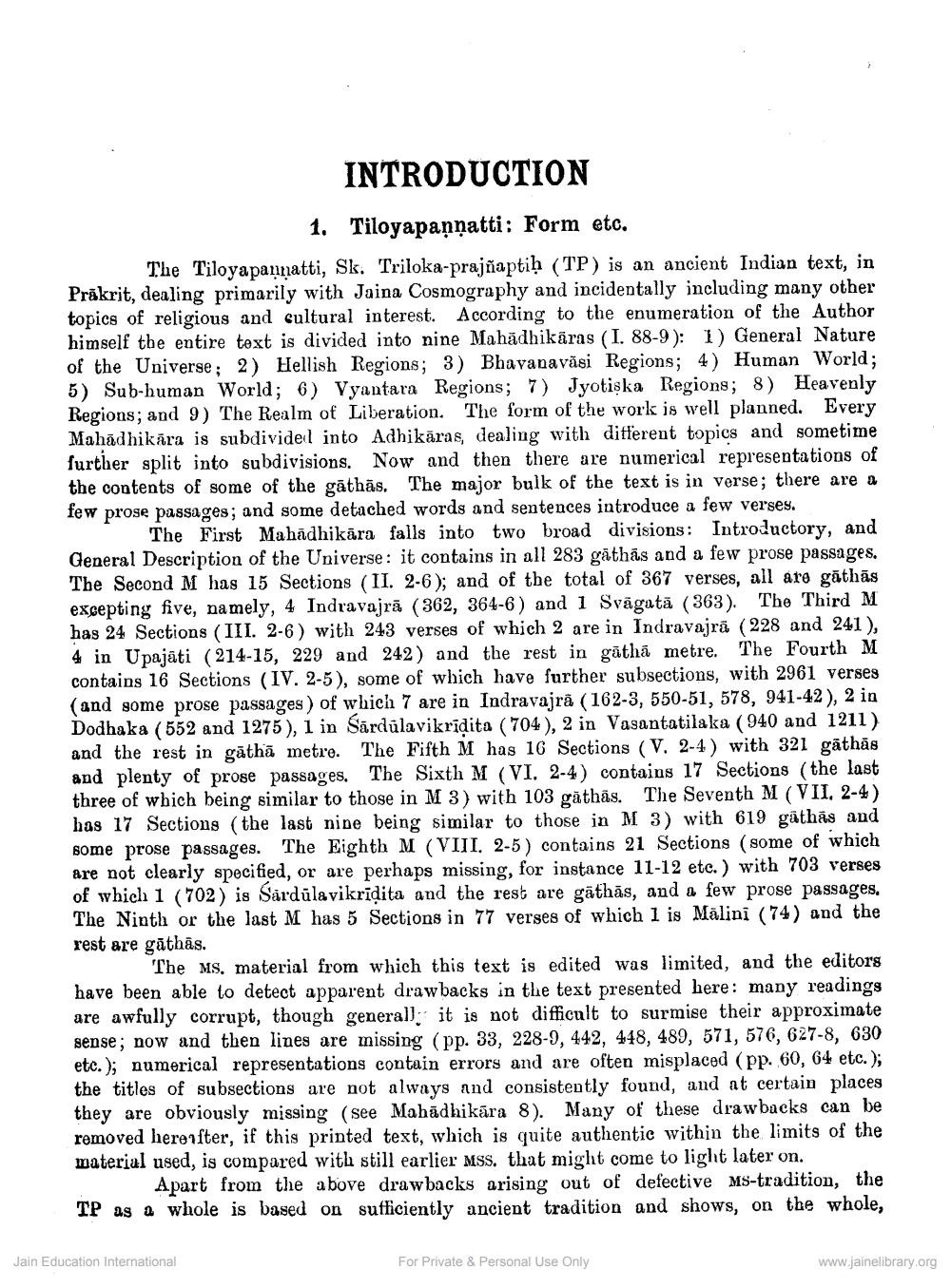________________
INTRODUCTION
1.
Tiloyapannatti: Form etc.
The Tiloyapannatti, Sk. Triloka-prajñaptih (TP) is an ancient Indian text, in Prākrit, dealing primarily with Jaina Cosmography and incidentally including many other topics of religious and cultural interest. According to the enumeration of the Author himself the entire text is divided into nine Mahādhikāras (I. 88-9): 1) General Nature of the Universe; 2) Hellish Regions; 3) Bhavanavăși Regions; 4) Human World; 5) Sub-human World; 6) Vyantara Regions; 7) Jyotiska Regions; 8) Heavenly Regions; and 9) The Realm of Liberation. The form of the work is well planned. Every Mahādhikāra is subdivided into Adhikaras, dealing with different topics and sometime further split into subdivisions. Now and then there are numerical representations of the contents of some of the gāthās. The major bulk of the text is in verse; there are a few prose passages, and some detached words and sentences introduce a few verses.
The First Mahādhikāra falls into two broad divisions: Introductory, and General Description of the Universe: it contains in all 283 gäthás and a few prose passages. The Second M has 15 Sections (II. 2-6); and of the total of 367 verses, all are găthās excepting five, namely, 4 Indravajrā (362, 364-6) and i Svāgatā (363). The Third M has 24 Sections (III. 2-6) with 243 verses of which 2 are in Indravajrã (228 and 241 ), 4 in Upajāti (214-15, 229 and 242) and the rest in gāthā metre. The Fourth M contains 16 Sections (IV. 2-5), some of which have further subsections, with 2961 verses (and some prose passages) of which 7 are in Indravajra (162-3, 550-51, 578, 941-42), 2 in Dodhaka (552 and 1275), 1 in Sārdūlavikrīdita (704), 2 in Vasantatilaka (940 and 1211 ) and the rest in gāthā metre. The Fifth M has 16 Sections (V. 2-4) with 321 gāthās and plenty of prose passages. The Sixth M (VI. 2-4) contains 17 Sections (the last three of which being similar to those in M 3) with 103 găthâs. The Seventh M (VII, 2-4) has 17 Sections (the last nine being similar to those in M 3) with 619 gathās and some prose passages. The Eighth M (VIII. 2-5) contains 21 Sections (some of which are not clearly specified, or are perhaps missing, for instance 11-12 etc.) with 703 verses of which 1 (702) is Sardūlavikridita and the rest are gathās, and a few prose passages. The Ninth or the last M has 5 Sections in 77 verses of which 1 is Mālini (74) and the rest are gāthās.
The Ms. material from which this text is edited was limited, and the editors have been able to detect apparent drawbacks in the text presented here many readings are awfully corrupt, though general), it is not difficult to surmise their approximate sense; now and then lines are missing (pp. 33, 228-9, 442, 448, 489, 571, 576, 627-8, 630 etc.); numerical representations contain errors and are often misplaced (pp. 60, 64 etc.); the titles of subsections are not always and consistently found, and at certain places they are obviously missing (see Mahādhikāra 8). Many of these drawbacks can be removed hereafter, if this printed text, which is quite authentic within the limits of the material used, is compared with still earlier Mss. that might come to light later on.
Apart from the above drawbacks arising out of defective ms-tradition, the TP as a whole is based on sufficiently ancient tradition and shows, on the whole,
Jain Education International
For Private & Personal Use Only
www.jainelibrary.org




